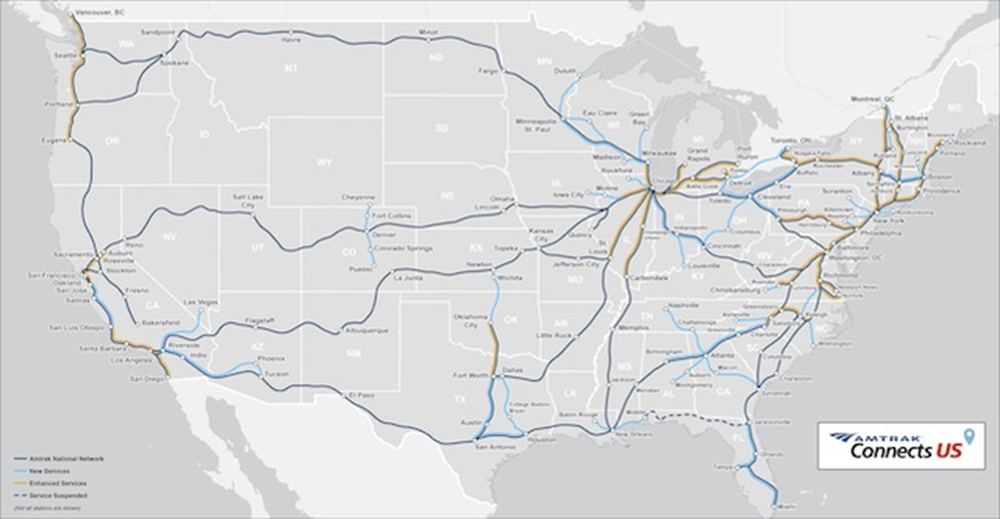During the House floor session Thursday, legislators announced the formation of the Train Travel Caucus in the Tennessee General Assembly, in support of expanding the taxpayer-subsidized National Railroad Passenger Corporation, known as Amtrak, into Tennessee.
The announcement came from a Democrat lawmaker, Representative Jason Powell (D-Nashville), who is the House sponsor of HB2278. The bill directs the Tennessee Advisory Council on Intergovernmental Relations (TACIR) to study within its existing resources the cost, feasibility and infrastructure of expanding railroad passenger service in the state through the National Railroad Passenger Corporation, doing business as Amtrak.
TACIR was created by the Tennessee General Assembly in 1978 in response to a need for a permanent intergovernmental body, comprised of legislators as well as members from municipal, county and state government, to study and act on issues that overlap federal, state and local government.
In extending an invitation to join the Train Travel Caucus, Powell said to his House colleagues, “Any members that are interested in expanding train service across the state of Tennessee for passenger rail, this is the time for Tennessee to do that.”
Not unlike the proposed Interstate Compact with Arkansas and Mississippi, the timing is related to gaining access to federal dollars made available through the November passage of the $1.2 trillion bipartisan Infrastructure Investment and Jobs Act, which included funding for Amtrak.
“There’s a lot of movement with the infrastructure bill that’s passed, $66 billion going specifically to rail,” said Powell.
What wasn’t mentioned is any of the data points that show Amtrak is a failed enterprise both in terms of its financial model and usefulness to travelers, as reported by the Cato Institute think tank in a policy handbook and a commentary about Amtrak’s profitability “big lie,” such as:
– when the market drove a number of railroads into bankruptcy, Congress took over passenger rail by creating Amtrak in 1970. Amtrak was supposed to be self-supporting after a transition period, but it has never covered its own costs, never mind made a profit
– in its first 49 years of existence, Amtrak has received more than $100 billion in taxpayer subsidies
– 17 state legislatures gave Amtrak a total of $234 million in 2019 alone, but Amtrak counts those taxpayer subsidies as “passenger revenues”
– federal, state and local subsidies to air and highway travel average around a penny per passenger mile, while Amtrak subsidies in 2019 were 34 cents per passenger mile
– Amtrak has a deferred maintenance backlog of $38 billion on the Boston-to-Washington corridor alone, which would eat up most of the Amtrak funding included in the infrastructure package
– the profitable runs are in the Northeast, and the biggest losers are the long-distance routes
As far back as 1958, the U.S. Interstate Commerce Commission issued the “Railroad Passenger Train Deficit” report about the amount by which the revenues from railroad passenger-service operations fall short of covering operating expenses, taxes and net rents. The report showed on page 75 of the 84-page report that from 1936 to 1957, when rail represented a much higher percentage of passenger travel than it does now, in no year was there a profit. Rather, the range in deficit was a low of $89 million to a high of $723 million.
[wonderplugin_pdf src=”https://thestarnewsnetwork.com/wp-content/uploads/2022/02/1958_HosmerReport.pdf” width=”100%” height=”600px” style=”border:0;”]
Additionally, The Antiplanner reports, intercity passenger rail service has declined significantly since its peak in 1920. By 1960, intercity trains carried less than 1.5% of passenger travel and less than 0.3% in 1970, the last year of private passenger service. After Amtrak took over, it represented just 0.16% of passenger travel, and was down to 0.11% in 2019.
Amtrak’s vitality to the nation’s economy is Amtrak’s biggest lie, according to the Cato commentary.
“Last year [2019], Americans traveled an average of 15,000 miles by automobile, 2,100 miles by plane, and 1,100 miles by bus. Amtrak’s contribution was less than 20 miles per person. Even in the Northeast Corridor, Amtrak reluctantly admits that it carries only 6% of intercity travelers.”
U.S. News and World Report points out that Amtrak is for the one percent, with an estimated 99 percent of Americans not using the most-ridden Northeast corridor at all. Those who do, “Amtrak boasts, are ‘highly educated, affluent and influential” with 92 percent having college degrees and an average household income of $170,000. Meanwhile, taxpayers are subsidizing $60 of each Amtrak ticket for the “wealthy and well-connected.”
On the House floor, Powell went on to portray that many of the country’s most populous cities in Tennessee are underserved by the passenger rail service.
“And Nashville is the third-largest city without Amtrak in the country, Knoxville is the seventh-largest city in the country without Amtrak, and Chattanooga is the 19th-largest city. There’s a lot of other communities and great opportunities.”
“The current proposal that has come out from Amtrak shows a line coming from Atlanta to Chattanooga with stops in Tullahoma, Murfreesboro and Nashville. There’s a lot of excitement about a track coming to Bristol. We want to make sure it doesn’t just stop in Bristol, it goes through Bristol. And, of course, we want to take this across the state.”

Map by Amtrack
Powell encouraged bipartisan support for getting Amtrak expanded in Tennessee.
“So, any of you that are interested, we want to make this a bipartisan effort. I’ve had a lot of members come up to me and express willingness to be a part of it, so I really appreciate that. We want to make this a bipartisan effort to help the state of Tennessee increase passenger rail service and make sure that we are ahead and all on board for passenger rail in the state of Tennessee,” said Powell, before acknowledging several House members who have expressed interest, including Speaker Cameron Sexton (R-Crossville).
“Thank you, Mr. Speaker, for the time and for speaking to me about this.”
If you’re interested, please see me, Representative [Yusuf] Hakeem (D-Chattanooga). Representative [Eddie] Mannis (R-Knoxville) is also assisting and Representative [John] Crawford (R-Bristol/Kingsport) agreed to sign on. If any of the members, please see us, we’d love to have you as a member of the Tennessee Train Travel Caucus,” Powell concluded.
After a couple more announcements, Representative Dwayne Thompson (D-Memphis) was recognized by the Speaker to share with his fellow members, “We were just discussing the Train Caucus and just wanted to mention there is one city in the state that does have Amtrak and it is also one of the largest train centers in the United States and the gateway to the west is Memphis, Tennessee. So, I definitely want to be involved in the Train Travel Caucus.”
Representative G. A. Hardaway (D-Memphis) also expressed his support, saying, “Mr. Speaker, we’re looking forward to having all of the legislature in a couple of club cars from Nashville to Memphis, Tennessee, Barbecue all the way!”
Powell’s HB2278 is on the House Transportation calendar for March 1 and the companion SB2602 by Senator Heidi Campbell (D-Nashville) is scheduled for the Senate Transportation Committee on March 2.
Another bill requiring TACIR to conduct a study and make recommendations regarding the potential for passenger rail that would link the major cities in each of the state’s grand divisions is HB2380 sponsored by Representative Antonio Parkinson (D-Memphis) and the companion SB2343 by Senator and Republican Caucus Chairman Ken Yager (R-Kingston). The bills are also scheduled to be heard in the respective Transportation committees next week.
– – –
Laura Baigert is a senior reporter at The Star News Network, where she covers stories for The Tennessee Star and The Georgia Star News.
Photo “Jason Powell” by Rep. Jason Powell. Background Photo “Amtrak” by Trains In The Valley. CC BY-SA 4.0.








